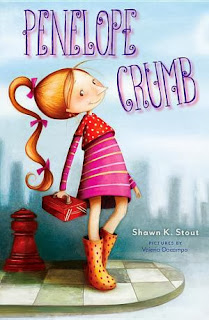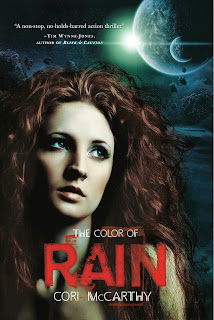by Cordelia Jensen
Hi, Amy Rose!
Entangled should be called Imagination.
There are so many, many unusual creatures and settings woven into this
narrative. Can you give us some insight into your imaginary world? Do these
strange characters/lands just come to you fully birthed or do you work hard to
conjure them up?
Creating the universe of Entangled
was different from any other story I’d written with a big world. I usually
have notebooks stuffed with details (in fact, one of the characters who’s
obsessed with her notebooks might be a little bit based on me…) But in this
case, I started writing and let myself discover the characters and worlds as I
went. It was like going on a long trip and being open to whatever you see along
the way, and finding the connections those things have to what you’re already
thinking about. I would let myself be surprised by the characters and weird
alien species and the black holes and then I would ask if they connected to the
story I was telling. Almost always, the answer was yes! Which was WEIRD, but
that’s okay. Brains are weird.
Agreed. Brains are weird.
I remember hearing a
part of this story at your graduate reading at VCFA. What I remembered the most
from the reading was the image of Cade with her bright red guitar on this
lonely grey planet. Did she come to you first?
Wow, it’s incredible that you could pinpoint this so
specifically. That’s exactly what I had first. Before I knew anything about
quantum entanglement, before I had any idea about the plot or the other
characters, I had a girl and her guitar on a dusty, unfriendly planet in the
fringes of space. That was all I had—for years! I just let her wander around my
head in search of the right story.
I'm glad you found it!
How much scientific
research did you do for this story? How much of the science is real? How much
is invented?
The idea for the plot sprang from my best friend, a
scientist, telling me about quantum entanglement. To be fair, she tells me
about all kinds of amazing scientific studies, discoveries, and theories, and
all of them deserve their own novels. This one just happened to collide with
the punk-rock space girl in my head, and the fact that she was so isolated.
Entanglement is a radical form of connection between particles, working faster
than the speed of light. I stretched the idea to apply to people, but even in
stretching it, I tried to use scientific details (like the newly discovered
Higgs field!) because I’m a huge nerd. I needed to be able to suspend my own
disbelief!
I also love thinking about what the future will bring in
terms of science, things we can barely imagine now. There is so much wonder and
strangeness. I read books and blogs, listen to podcasts and scour science
articles. That being said, there is an element of fantasy mixed into Entangled and, even more, the sequel.
There’s always an element to radical new discoveries that we can’t understand,
that defies our rules and our boxes, that knocks down a new wall in our minds.
Fantasy gives us that same feeling, so to me, it fits.
I know you have some
background as a screenwriter. How does this inform your fiction writing? Do you
see your scenes in your head like movie scenes?
I wrote many many screenplays before I came back around to
novels. It was a great learning experience. I got to spend a lot of time on
dialogue, which I’ve always loved, and structure, which I’ve always been scared
of. And I’ve never been very visual, so it’s a good challenge for me to see the scene before I write it. It was
actually when I combined what I learned from screenwriting with my flailing
attempts to write a novel that things started to work!
Can you give us some
hints about stories you are working on now?
Just yesterday, I handed in the second draft of the sequel
to ENTANGLED, which is called UNMADE. It’s the second book, and the end of the
story. My publisher calls it a space duet, which I love! I’m going to miss Cade
and Lee and Rennik and ALL OF THEM, but now I get to work on new things! I have
about nine ideas that are all fighting for a place in line.
Awesome!
Is there anything
else you want our readers to know about Entangled
or you as an author?
Almost everything I write has a fantasy or science fiction
element, even if it’s small, because that’s what I love to read. I don’t see
the world in a very “realistic” way, so finding SFF was a comfort because it showed
me I wasn’t alone. It all comes down to perspective, I think. Using your
imagination is just a different angle of looking at the same world.
Also, I loved writing Entangled
and living in the voice and world of that story. But I jump around a lot!
I’m learning that I don’t really have one voice as a writer, or one kind of
book that I love best.
And now for our
regular “3 for 3 book questions:”
What were your 3
favorite stories from your childhood/teen years?
How is this a hard question, every time? I’ll go with His Dark Materials by Philip Pullman, anything by Madeleine L’Engle, and The Stories of Ray Bradbury. I know that
I picked a trilogy, an author, and a collection of 100 short stories. I know
that I cheated.
What are 3 books you
have read recently that surprised you?
I like this question! Books can be surprising for so many
different reasons. The last book I read was All
the Truth That’s In Me by Julie Berry. I was surprised by how she combined
small poetic moments with tight pace and suspense. I loved it!
Before that, I read Parched
by Melanie Crowder. I knew it was going to be an incredible read, but I’m
always so impressed when someone can pull off the point of view of a non-human
character.
A realistic YA that stood out to me lately is Blaze (or Love in the Time of Supervillains)
by Laurie Boyle Crompton. I was surprised by how much and how hard I
laughed, and that is always a great thing.
What are 3 books that
inspire/d your writing?
A book that inspired me in writing Entangled is Cosmicomics by
Italo Calvino, who has this incredible way of combining scientfic concepts and
unexpected characters and poetic language. It’s not YA, though! I wouldn’t have
any idea where to shelve it, and I love those books.
I’m a huge fan of A
Wrinkle in Time, but I have to mention Madeleine L’Engle’s book A Ring of Endless Light, (about
dolphins! and telepathy! and poetry!) because
it gave me some of my first ideas about how a story can involve emerging
science as well as fantastic elements and realistic characters.
I’m really inspired by ambitious and unique YA writers, like
A.S. King. Her book Ask The Passengers is
so beautiful, and it makes me want to be even braver in my own writing.
Thanks!!!! I really
enjoyed reading Entangled and the
world is lucky that it has hit the stores this month.
Amy Rose Capetta graduated from Vermont College of Fine Arts with an MFA in Writing for Children and Young Adults. She has lived all over the country, and is currently located in Michigan. Her first novel, Entangled, is one half of a space duet. The sequel, Unmade, is forthcoming from HMH in 2014.
If you're local to the area, please let the bookstore know if you would like to place a special order for Entangled. You can email orders to orders [at] bigbluemarblebooks [dot] com, call (215) 844-1870, or come see us at 551 Carpenter Lane, in the Mt. Airy neighborhood of Philadelphia.
Please look for Jen's interview with the amazingly talented David Wiesner coming in early November!




















